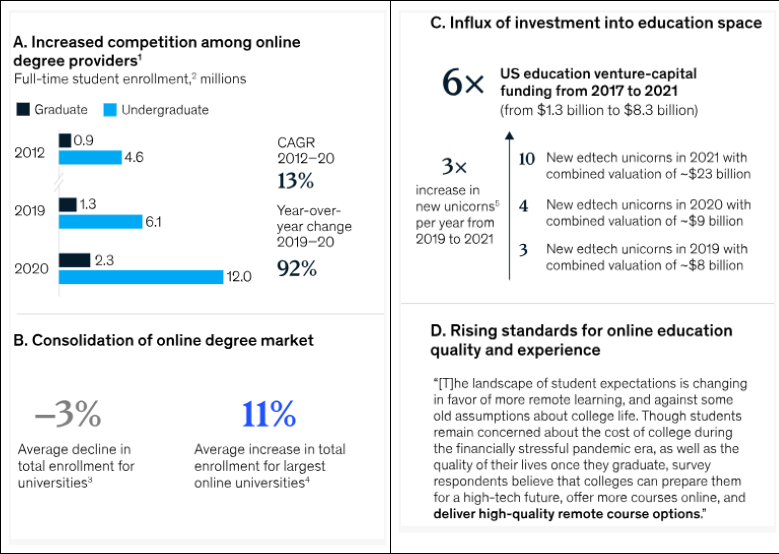E-learning wasn’t all that popular a decade ago, but after the pandemic, it exploded and became quite popular. You may estimate the popularity of eLearning by noting that its market size was $56.2 billion in 2013 and will grow to $1 trillion by 2023 after reaching 399.3 billion in 2022.
Source: Global Market Insights
Massive open online courses (MOOCs) reached 220 million students by the end of 2021, up from 300,000 in 2011, reports McKinsey.
Of course, online learning, usually referred to as e-learning, has gained popularity as a substitute for traditional teaching techniques. However, just as every coin has two sides, so does online learning. In this blog article, we’ll look at the pros and cons of traditional and online learning techniques.
4 Core Market Forces Shaping the Online Education Space
 Source: McKinsey
Source: McKinsey
E-Learning: Pros
1. Flexibility and Convenience:
One of the biggest advantages of e-learning is its flexibility. Students can access course materials and study at their own place and time, making it convenient for those who have other commitments like work or family responsibilities. E-learning allows individuals to learn from anywhere, eliminating the need for physical attendance in a classroom.
2. Access to a Variety of Courses and Resources
With e-learning, you have a variety of possibilities and may learn from renowned universities across the globe from the comfort of your home. You can pick the classes you like, no matter where you live. Also, online classes make learning more fun and interesting by offering resources such as fun videos., experiential learning tools, etc.
3. Cost-Effective
E-learning can be cheaper than going to a regular school. You don’t have to spend money on traveling and lodging. Plus, online classes can cost less, and you don’t always need to buy expensive books because the edtech companies offer online free learning resources you can access as per your convenience.
E-Learning: Cons
1. Less Social Interaction
One disadvantage of e-learning is the reduced opportunity for interaction with classmates and teachers. In traditional learning children socialize, collaborate, and build networks that may not be readily available in an online environment. Lack of face-to-face interactions and group activities may have an effect on a person’s ability to communicate, work well with others, and enhance emotional intelligence.
2. Self-Motivation and Discipline
E-learning means you have to motivate yourself and be disciplined because class times are flexible. Some students might find it hard to stay on track without the regular schedule of traditional classes. If you don’t manage your time well and stay dedicated, you might end up hesitating and not making good progress in your learning.
3. Technical Challenges
Technological issues can pose challenges in e-learning. Students need a good internet connection and access to proper devices to take advantage of online courses. Technical glitches, connectivity problems, or compatibility issues with certain software can break the learning process and cause frustration.
Traditional Learning: Pros
1. Interaction and Collaboration
Traditional learning encourages face-to-face interaction with teachers and classmates. Classroom discussions, group activities, and debates facilitate the exchange of ideas. This interactive environment allows you to learn critical thinking, social skills, and teamwork.
2. Personalized Attention
In regular school, you can talk to your teacher anytime and get quick answers and help. Teachers can work with you one-on-one, see how you’re doing, and teach in a way that helps you the most. This makes learning better and helps when you have problems you can easily ask for help for study.
3. Networking Opportunities
In regular school, you can make friends and meet teachers and people who do the same job you are learning. This can help you learn from experts, find jobs, and work together on cool projects. Going to school in person lets you join events and meetings where you can meet these people.
Traditional Learning: Cons
1. Time and Place limitation:
Regular school means you have to go to a specific place at set times. This can take up time and might cost money for transportation. Sometimes, the school schedule can clash with other things you need to do, making it hard to manage your time.
2. Limited Course Options
Traditional learning may have limitations in terms of available courses, and subjects offered. Smaller institutions might have a narrower range of choices compared to online platforms. This could limit students who have specific interests or who want to explore more subjects.
3. Higher Costs
Going to a regular school can cost a lot more than learning online. You might have to pay for school fees, a place to stay, getting to school, and buying books. This can be really hard for people who are not economically sound.
Conclusion
Online learning and regular school both have good and not-so-good parts. Online learning is flexible, has lots of classes, and can save money. But regular school lets you socialize, get special help, and meet others in your field. Which one is better depends on how you like to learn and what’s going on in your life. Sometimes, a mix of both can be the best way to learn.
Moonpreneur is on a mission to disrupt traditional education and future-proof the next generation with holistic learning solutions. Its Innovator Program is building tomorrow’s workforce by training students in AI/ML, Robotics, Coding, IoT, and Apps, enabling entrepreneurship through experiential learning.


























I want to learn a new skill quickly. Can e-learning be faster?
E-learning often allows you to focus on specific modules, potentially speeding up the learning process compared to a traditional semester-long course.